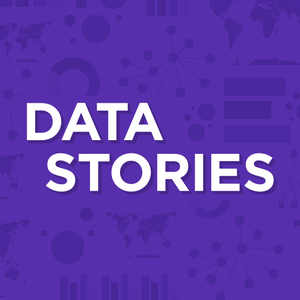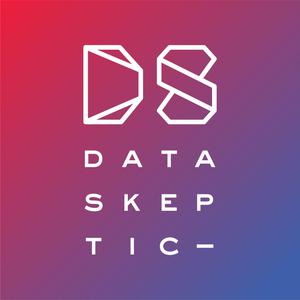
Data Stories
Enrico Bertini and Moritz Stefaner
A podcast on data and how it affects our lives — with Enrico Bertini and Moritz Stefaner
- 1 hour 3 minutes170 | Formalizing Design with Gabrielle Mérite and Alan Wilson

 Data design systems and styleguides are currently a huge trend in the data design world. Moritz is joined by Gabrielle Mérite and Alan Wilson and together we exchange experiences in this emerging space, from designing dataviz components as part of Adobe Spectrum, the styleguide for Deloitte’s Insights Magazine or the WHO Data Design Language. Gabriele also wrote about adding touches of ethical guidance in guidelines in one of her recent newsletters. Enjoy!
Data design systems and styleguides are currently a huge trend in the data design world. Moritz is joined by Gabrielle Mérite and Alan Wilson and together we exchange experiences in this emerging space, from designing dataviz components as part of Adobe Spectrum, the styleguide for Deloitte’s Insights Magazine or the WHO Data Design Language. Gabriele also wrote about adding touches of ethical guidance in guidelines in one of her recent newsletters. Enjoy!Related episodes
8 March 2023, 12:40 pm - 1 hour 8 minutes169 | Data Conversations with Vidya Setlur

We have Vidya Setlur on the show to talk about the role language, and natural language processing (NLP) play in data visualization and analytics.
Vidya is the director of research at Tableau and has a background in natural language processing and visualization. She is one of the main drivers behind Eviza, a research-based prototype and the corresponding product Ask Data, developed within Tableau to interact with data visualizations through natural language.
She is also the co-author, with Bridget Cogley, of Functional Aesthetics for Data Visualization, a new book on data visualization with a lot of information about semantics and language in data visualization.
In the episode, we talk about the challenges of going from a research prototype to an actual product, research vs. engineering, speech and natural language interfaces, the many ways language plays a role in visualization, the advent of language models, and much more.
Enjoy the show!
Links
- Winners of Information is Beautiful Awards
- Book: Functional Aesthetics for Data Visualization
- Paper: Automatic Generation of Semantic Icon Encodings for Visualizations
- Paper: A Linguistic Approach to Categorical Color Assignment for Data Visualization
- Eviza: A Natural Language Interface for Visual Analysis
- Paper: Snowy: Recommending Utterances for Conversational Visual Analysis
—
Remember: our podcast is listener-supported. Please consider donating using Patreon or Paypal. Thanks! ?
Related episodes
12 December 2022, 2:07 pm - 57 minutes 26 seconds168 | Highlights from IEEE VIS'22 with Tamara Munzner
 Finally, this year we managed to record another classic episode from the IEEE VIS Conference (we recorded a total of 10 with this one!) We have Data Stories’ friend Prof. Tamara Munzner with us to talk about the conference and to highlight a few things she picked from the many events that happened over this week-long event.
Finally, this year we managed to record another classic episode from the IEEE VIS Conference (we recorded a total of 10 with this one!) We have Data Stories’ friend Prof. Tamara Munzner with us to talk about the conference and to highlight a few things she picked from the many events that happened over this week-long event.Links
- IEEE Vis ’22
- Our guest: Tamara Munzner
- VIS Keynote: Marti Hearst – Show It or Tell It?
- VIS Capstone: Kerry Magruder – Galileo’s Telescope Discoveries: Thinking Visually in the History of Science
- Keynote BELIV workshop: Casey Fiesler – Data Is People, Research Ethics Beyond Human Subjects
- VAST 10 Year Test of Time Award: Enterprise Data Analysis and Visualization: An Interview Study
- InfoVis 10 Year Test of Time Award: Design study methodology: Reflections from the trenches and the stacks
- Paper: HiTailor: Interactive Transformation and Visualization for Hierarchical Tabular Data
- Paper: Dashboard Design Patterns
- Book: AK Peters Visualization series
- Paper: VegaFusion: Automatic Server-Side Scaling for Interactive Vega Visualizations
- Paper: Plotly Resampler: Effective Visual Analytics for Large Time Series
- Paper: Visualizing Graph Neural Networks with CorGIE: Corresponding a Graph to Its Embedding
- alt.VIS workshop
- Jo Wood’s visual essay “Beyond the Walled Garden“
- Paper: Affective Learning Objectives for Communicative Visualizations
Related episodes
- from Visweek 2012
- IEEE VIS'13 Highlights w/ Robert Kosara
- IEEE VIS'14
- Tamara Munzner
- IEEE VIS’15 Recap with Robert Kosara and Johanna Fulda
- Highlights from IEEE VIS'16 with Jessica Hullman and Robert Kosara
- Review of IEEE VIS’17 with Jessica Hullman and Robert Kosara
- Highlights from IEEE VIS 2018
- Highlights from IEEE VIS'19 with Tamara Munzner and Robert Kosara
- Highlights from IEEE VIS'20 with Miriah Meyer and Danielle Szafir
21 November 2022, 6:07 pm - 49 minutes 26 seconds167 | Visualization and Statistics with Andrew Gelman and Jessica Hullman


In this new episode, we talk about the interplay between statistics and data visualization. We do that with Andrew Gelman, Professor of Statistics and Political Science at Columbia University, and Jessica Hullman, Professor of Computer Science at Northwestern University. Andrew started the popular blog “Statistical Modeling, Causal Inference, and Social Science,” which has an active community of readers and has been around for many years. Jessica started contributing lately with many exciting posts, several of which have to do with data visualization. In the episode, we touch upon many topics, including the story behind the blog, the role of surprises, anomalies, and storytelling in science, the Anscombe’s quartet, and exploratory data analysis.
Links
- Jessica Hullman: http://users.eecs.northwestern.edu/~jhullman/
- Andrew Gelman: http://www.stat.columbia.edu/~gelman/
- Blog: Statistical Modeling, Causal Inference, and Social Science: https://statmodeling.stat.columbia.edu/
- Andrew’s 2003 paper on visualization as model checks: “Exploratory Data Analysis for Complex Models”
- Jessica and Andrew’s follow-up article expanding on the idea of model checks for visualization research: “Designing for Interactive Exploratory Data Analysis Requires Theories of Graphical Inference”
- Andrew and Thomas’ paper on stories in social sciences: “When Do Stories Work? Evidence and Illustration in the Social Sciences”
—
Remember: our podcast is listener-supported; please consider donating Using Patreon or Paypal. Thanks!
Related episodes
6 October 2022, 2:13 am - 59 minutes 24 seconds166 | Catching up with Amanda Makulec

Hey all, we are back!
In this episode, we have Amanda Makulec to catch up on what happened during this whole period of time.
Amanda is a public health and data visualization expert and she is the Executive Director of the Data Visualization Society.
In the episode, we talk about the Data Visualization Society, the new Information is Beautiful Awards (now organized by the DVS team), and how visualization has evolved lately.
Links
- WHO Data Design Language
- Climate & Conflict Analysis for German Foreign Office
- Enrico’s FILWD Newsletter
- https://www.amandamakulec.com
- https://twitter.com/abmakulec
- https://www.datavisualizationsociety.org
- https://www.informationisbeautifulawards.com/awards/2022
- Frank Elavsky (A11y work in vis)
- Uncertainty visualization work (Jessica Hullman and Matthew Kay)
- Data Humanism (Giorgia Lupi)
- Moritz’s keynote at EUROVIS
- Crystal Lee’s work on how vis is used for covid19 communication
- Why Shouldn’t All Charts Be Scatter Plots? Beyond Precision-Driven Visualizations
- Joss Fong’s Automating Bias
- Warming stripes
—
Remember: our podcast is listener-supported, please consider making a donation! Using Patreon or Paypal. Thanks

Related episodes
9 September 2022, 2:30 pm - 49 minutes 52 seconds165 | Data Visualization Accessibility with Sarah Fossheim

Visualization is a very powerful cognitive tool. I think we all agree with that. But what happens if a person is visually impaired or has other impairments that prevent them to fully benefit from it? It’s surprising, despite the huge success visualization had during these last few years, how little we have to show in terms of supporting this very relevant segment of the population.
To discuss this topic we have on the show Sarah Fossheim. Sarah is a full-stack developer and UX researcher with a specific expertise on accessible design for data visualization projects. See for instance their “How to create a screen reader accessible graph like Apple’s with D3.js“.
On the show, we talk about what is accessibility and what role it plays in data visualization, how to make charts and visual representations more accessible, and how to get started with accessible design.
This is a hugely important topic and we hope you will find some inspiration by listening to it!
Links:
- https://fossheim.io
- https://twitter.com/liatrisbian
- Chartability <https://chartability.fizz.studio>
- Dataviz Accessibility Resources <https://github.com/dataviza11y/resources>
- Outlier 2021—Are your visualizations excluding ppl?
- Writing Alt Text for Data Visualization
- Apple previews powerful software updates designed for people with disabilities
- Summarizing Information Graphics Textually
- Loud Numbers Podcast
- DS 075 | Listening to Data From Space with Scott Hughes
—
Remember: our podcast is listener-supported, please consider making a donation! Using Patreon or Paypal. Thanks

Related episodes
21 July 2021, 6:45 pm - 1 hour 6 minutes164 | Edward Tufte's complete work with Sandra Rendgen

We have our friend Sandra Rendgen on the show to talk about the work of Edward Tufte. Tufte does not need any introductions of course. We discuss his early works and efforts, all the books he published, his contribution and legacy and the influence he had on our work.
Enjoy the show!
Remember: our podcast is listener-supported, please consider making a donation! Using Patreon or Paypal. Thanks

Links
- Impfdashboard <https://impfdashboard.de>
- Enrico’s ML vis work: Slice Lens <https://github.com/nyuvis/SliceLens>
- Observable notebooks for teaching <https://observablehq.com/collection/@nyuvis/guides-and-examples>
- Our guest: Sandra Rendgen <https://sandrarendgen.wordpress.com/>
- First book “The Visual Display of Quantitative Information” and how it influenced a lot of people <https://www.edwardtufte.com/tufte/books_vdqi>
- Second book “Envisioning Information” <https://www.edwardtufte.com/tufte/books_ei>
- Third book “Visual Explanations: Images and Quantities, Evidence and Narrative”<https://www.edwardtufte.com/tufte/books_visex>
- Fourth book “Beautiful Evidence” <https://www.edwardtufte.com/tufte/books_visex>
- Fifth book “Seeing with Fresh Eyes: Meaning, Space, Data, Truth“ <https://www.edwardtufte.com/tufte/seeing-with-fresh-eyes>
- Robert Kosara’s review of Tufte’s workshops <https://eagereyes.org/criticism/edward-tufte-one-day-course>
9 March 2021, 3:57 am - 47 minutes 19 seconds163 | svelte.js for web-based dataviz with Amelia Wattenberger
 This week, we are joined by Amelia Wattenberger, journalist-engineer at the Pudding and book author. We discuss the exciting Svelte framework for web development, which is especially well suited for developing interactive data visualizations. Hear how it compares to other frameworks like react, why web development nowadays seems so complicated, and finally, hear a few ideas for last minute dataviz-related present ideas for the holiday season
This week, we are joined by Amelia Wattenberger, journalist-engineer at the Pudding and book author. We discuss the exciting Svelte framework for web development, which is especially well suited for developing interactive data visualizations. Hear how it compares to other frameworks like react, why web development nowadays seems so complicated, and finally, hear a few ideas for last minute dataviz-related present ideas for the holiday season 
Links
- Svelte tutorial
- svelte.recipes
- Svelte Radio
- Mathias Stahl: How you setup data visualization with Svelte
- Layercake
- “I am a book. I am a portal to the universe.”
- Pilot G-Tec C4
- https://www.madefromdata.com/products
- https://frontendmasters.com/courses/d3/
- https://frontendmasters.com/courses/svelte/
Remember: our podcast is listener-supported, please consider making a donation! Using Patreon or Paypal. Thanks

Related episodes
14 December 2020, 2:50 pm - 1 hour 13 minutes162 | Highlights from IEEE VIS'20 with Miriah Meyer and Danielle Szafir


Hey all, we are back! In this classic episode we go over highlights from the IEEE VIS’20 conference. We cover a broad set of themes with Danielle Szafir from University of Colorado and Miriah Meyer from University of Utah, who helped us explore latest trends in visualization. See the main links and details in the show notes below. There is a lot to explore!
Remember: our podcast is listener-supported, please consider making a donation! Using Patreon or Paypal.
Links
Topic: IEEE VIS conference <http://ieeevis.org/year/2020/welcome>
Miriah Meyer <http://www.cs.utah.edu/~miriah/>
Danielle <https://danielleszafir.com>
PolicyViz episode on IEEE VIS 2020: <https://policyviz.com/podcast/episode-184-ieeevis-recap/>
Short paper: Why Shouldn’t All Charts Be Scatter Plots? Beyond Precision-Driven Visualizations: <https://arxiv.org/abs/2008.11310>
John Burn-Murdoch’s BELIV workshop keynote: <https://youtu.be/xlN_QUdT6os>
Short paper: Designing for Ambiguity: Visual Analytics in Avalanche Forecasting: <https://arxiv.org/abs/2009.02800>
Vis Psychology workshop: <https://sites.google.com/view/vispsych/>
Barbara Tversky’s keynote: <https://youtu.be/GLiFg3M70Mk?t=1090>
Paper: Visual reasoning strategies for effect size judgments and decisions: <https://arxiv.org/abs/2007.14516>
Paper: Insight Beyond Numbers: The Impact of Qualitative Factors on Visual Data Analysis: <https://ieeexplore.ieee.org/stamp/stamp.jsp?arnumber=9241426>
Paper: A Design Space of Vision Science Methods for Visualization Research: <https://arxiv.org/abs/2009.06855>
Paper: Communicative Visualizations as a Learning Problem: <https://arxiv.org/abs/2009.07095>
Sheelagh Carpendale’s Capstone: <https://youtu.be/XQhBHnPIsRk>
Paper: Introducing Layers of Meaning (LoM): A Framework to Reduce Semantic Distance of Visualization In Humanistic Research: <https://projectcornelia.be/uploads/lamqaddam_vis_2020_preprint.pdf>
Paper: Insights From Experiments With Rigor in an EvoBio Design Study: <https://arxiv.org/abs/2008.11564>
Paper: Data Comics for Reporting Controlled User Studies in Human-Computer Interaction: <https://osf.io/unmyj>
Paper: Uplift: A Tangible and Immersive Tabletop System for Casual Collaborative Visual Analytics: <https://ialab.it.monash.edu/~dwyer/papers/uplift.pdf>
Short paper: The Anatomical Edutainer: <https://arxiv.org/abs/2010.09850>
Paper: Chemicals in the Creek: designing a situated data physicalization of open government data with the community: <https://arxiv.org/abs/2009.06155>
Druid <https://renecutura.eu/pdfs/Druid.pdf>
Calliope <https://ieeexplore.ieee.org/abstract/document/9222368>
Data GIFs <https://data-gifs.github.io>
Related episodes
11 November 2020, 4:09 pm - 39 minutes 50 seconds161 | People of the Pandemic with Shirley Wu
We have renowned data visualizer Shirley Wu with us again (we had her before in episode 98) to talk about a new project she and her team developed to help people reason about the covid19 pandemic at a local community level. The team developed a simulation game that shows you what happens when you make certain sets of decisions over time that may affect the spread of the virus. You can play with others and your goal is to cooperate. Needless to say the tool uses some really interesting visualizations also but this is not the main point. It’s interesting to see the intersection between data visualization, simulation and gaming. With Shirley we talk about how the project started, specific challenges they faced, how it was received, and future developments.
Other simulations:
Related episodes
3 June 2020, 3:44 pm - 52 minutes 8 seconds160 | Visualizing COVID-19 with Carl Bergstrom
 Photo Credit: Kris Tsujikawa
Photo Credit: Kris Tsujikawa
We hope everyone is doing well! We finally decided to record an episode on visualization and covid19. It’s been a crazy several weeks and one of the most interesting developments has been to see how prominent visualization has been in the constant flux of information. Who expected visualization to be so relevant, uh?!
And when we talk about data and pandemics we could not find a better person than Carl Bergstrom, Professor of Biology at University of Washington, with a background in epidemiology but also an expert in scientific practices and communication.
You may remember Carl from an episode about three years ago (Episode 97). We interviewed him together with his colleague Jevin West to talk about their excellent “Calling Bullshit” project (and let’s face it, there is no lack of BS during these crazy times), a course (and soon to be a book) on how to spot BS in science.
Carl has been a constant source of information and reasoning on Twitter. Commenting on the science behind pandemics but also about the way science is communicated and the many possible traps you may fall into. If there is one thing we all learned is that visualization without reliable data is a mess!
In the show, we talk about a number of iconic covid19 visualizations, the “flatten the curve” ones, the tracking lines from Financial Times and several simulations. For each of these we discuss the many variations and nuances, what we have learned from them and the many intricacies of creating visualizations for such a sensitive topic with potential huge outcomes.
[Our podcast is fully listener-supported. That’s why you don’t have to listen to ads! Please consider becoming a supporter on Patreon or sending us a one-time donation through Paypal. And thank you!]
Links:
- Prof. Carl Bergstrom
- Siouxsie Wiles’ Flatten the Curve cartoon
- Medium: Don’t Flatten the Curve
- Vox: Coronavirus mitigation could kill thousands. Suppress the virus, don’t just “flatten the curve.”
- Scientific American: Leading with the Unknowns in COVID-19 Models
- WaPo: Why outbreaks like coronavirus spread exponentially, and how to “flatten the curve”
- Carl’s tweet on normalizing by population size (or not?)
- Matthew Fox’s Tweet on Uncertainty Bounds in the IHME model
Stats and Tracking:
- COVID Projections Tracker
- FT’s tracker: Coronavirus tracked: the latest figures as countries fight to contain the pandemic
- Our World in data: Coronavirus Pandemic (COVID-19) – Statistics and Research
- John Hopkins tracker: COVID-19 Map – Johns Hopkins Coronavirus Resource Center
Visual Simulations:
- People of the Pandemic | a hyperlocal cooperative simulation game
- Why outbreaks like coronavirus spread exponentially, and how to “flatten the curve”
- What Happens Next? COVID-19 Futures, Explained With Playable Simulations
- Outbreak
Related episodes
20 May 2020, 7:13 pm - More Episodes? Get the App
- https://datastori.es
- en-US
Your feedback is valuable to us. Should you encounter any bugs, glitches, lack of functionality or other problems, please email us on [email protected] or join Moon.FM Telegram Group where you can talk directly to the dev team who are happy to answer any queries.
 The TWIML AI Podcast (formerly This Week in Machine Learning & Artificial Intelligence)
The TWIML AI Podcast (formerly This Week in Machine Learning & Artificial Intelligence)
 Up First from NPR
Up First from NPR
 DataFramed
DataFramed
 Hard Fork
Hard Fork
 99% Invisible
99% Invisible
 Data Skeptic
Data Skeptic